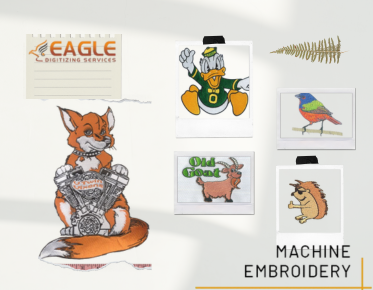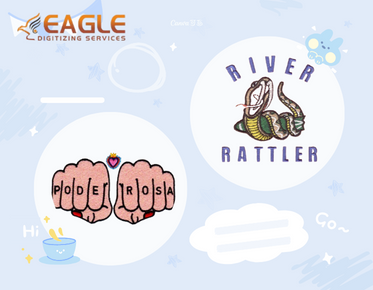How Environmental Education Inspires Vector Artists' Work
How Environmental Education Inspires Vector Artists' Work
In an era where every pixel can serve as a catalyst for change, the intersection of art and environmental advocacy has never been more pronounced. The digital age has empowered vector artists to wield their craft not just for aesthetic pleasure, but as a powerful tool for ecological consciousness. Through vibrant graphics and compelling visuals, they engage audiences and stimulate dialogue around pressing environmental issues. Understanding this dynamic connection reveals the profound influence of environmental education on artists who strive to make an impact through their work. Read Here are Some Things That You Should Know When It Comes To Embroidery Digitizing!
Understanding the Connection Between Environmental Education and Art
At the heart of this relationship lies an intricate tapestry woven from the threads of knowledge, creativity, and responsibility. Environmental education offers artists a framework to explore the complexities of our natural world, fostering an understanding that transcends mere observation. This educational foundation encourages artists to translate their insights into visual narratives, imbuing their work with urgency and relevance. The result is a symbiotic relationship where art becomes a conduit for advocacy, and education informs artistic expression.
The Role of Environmental Education in Shaping Artistic Perspectives
How Learning About Environmental Issues Inspires Creativity
Delving into environmental studies sparks a wellspring of creativity among artists. As they absorb knowledge about climate change, biodiversity loss, and sustainability, their imaginations begin to flourish. This newfound understanding encourages artists to explore themes of nature, interdependence, and the fragility of ecosystems, infusing their work with a sense of purpose. The creative process becomes an exploration of solutions, as artists envision alternative futures rooted in harmony with the environment.
The Impact of Ecological Literacy on Artistic Choices
Ecological literacy—understanding the relationships within ecosystems—plays a crucial role in shaping artistic choices. Artists equipped with this knowledge make informed decisions about subject matter, materials, and techniques, ultimately enhancing the depth of their work. They become advocates for sustainable practices, opting for eco-friendly materials and methods that minimize harm to the planet. This alignment of values and artistic expression creates a powerful narrative that resonates with viewers and promotes ecological stewardship.
Integrating Environmental Studies into Art Education Programs
How Art Schools Are Adapting Their Curriculums
Recognizing the importance of environmental education, art schools are increasingly integrating sustainability into their curriculums. Programs are evolving to include courses on ecological design, sustainable materials, and the intersection of art and activism. By equipping students with the knowledge and skills necessary to address environmental challenges, these institutions are cultivating a new generation of artists who are not only skilled creators but also informed advocates.
The Rise of Interdisciplinary Programs Merging Art and Environmental Science
The emergence of interdisciplinary programs that merge art and environmental science reflects a growing recognition of the interconnectedness of these fields. Students learn to blend artistic techniques with scientific principles, resulting in innovative projects that raise awareness about pressing environmental issues. This collaborative approach fosters creativity and critical thinking, encouraging students to envision solutions that transcend traditional boundaries.
Exploring Themes of Nature and Sustainability in Vector Art
How Environmental Education Influences Subject Matter in Vector Design
As vector artists become more attuned to environmental issues through education, the themes in their work evolve accordingly. Nature takes center stage, with designs that celebrate biodiversity, conservation, and sustainable practices. These visuals often serve as reminders of the beauty and fragility of the natural world, encouraging viewers to engage in discussions about their role in preserving it. This thematic shift reflects a growing desire among artists to communicate their passion for the environment through their craft.
The Shift Toward Nature-Inspired Aesthetics in Digital Art
The aesthetic landscape of digital art is undergoing a transformation, with nature-inspired elements gaining prominence. Artists are increasingly drawn to organic forms, earthy color palettes, and fluid shapes that evoke the beauty of the natural world. This shift toward a more ecological aesthetic not only enriches the visual experience but also reinforces the importance of sustainability. By celebrating the wonders of nature, vector artists invite their audiences to reflect on their connection to the environment.
The Importance of Field Studies for Vector Artists
Gaining Firsthand Experience: Why Field Trips Matter
Field studies play a vital role in enriching the artistic experience for vector artists. By immersing themselves in natural environments, artists gain firsthand insights that cannot be replicated in a classroom. Whether hiking through lush forests, exploring coastal ecosystems, or observing urban wildlife, these experiences ignite inspiration and inform their creative processes. Field trips allow artists to witness the beauty and complexity of nature, translating these experiences into compelling visual narratives.
Learning from Nature: How Immersion Shapes Artistic Expression
Immersion in nature cultivates a deeper understanding of ecological principles and interconnections. This profound engagement fosters a sense of responsibility, as artists become more attuned to the impacts of human activity on the environment. By reflecting on their observations, artists develop a unique lens through which to interpret and express their ideas. This immersion not only shapes their artistic expression but also reinforces the importance of environmental stewardship.
The Power of Vector Art in Environmental Campaigns
Creating Impactful Graphics for Advocacy
Vector art serves as a powerful tool for advocacy, capable of conveying complex ideas in a visually striking manner. Through compelling graphics, artists can distill intricate environmental issues into digestible visuals that resonate with diverse audiences. These graphics have the potential to inspire action, spark conversations, and mobilize communities around shared environmental goals. The clarity and scalability of vector art make it an invaluable asset for campaigns seeking to raise awareness and drive change.
Successful Examples of Vector Art in Environmental Awareness Campaigns
Numerous campaigns have effectively harnessed the power of vector art to amplify their environmental messages. From iconic posters to social media graphics, these visuals have captured the essence of pressing issues, such as climate change and conservation. Successful campaigns leverage the strength of vector art to engage audiences, encouraging them to take action and advocate for sustainable practices. These examples serve as a testament to the impact that well-crafted visuals can have in shaping public perception and behavior.
Exploring Environmental Justice Through Vector Art
How Artists Address Social and Environmental Issues
Vector artists are increasingly using their platforms to address the intersections of social and environmental issues. By highlighting themes of environmental justice, they shed light on the disproportionate impacts of climate change on marginalized communities. This advocacy work goes beyond aesthetics; it seeks to challenge systemic inequalities and promote equitable solutions. Through their art, these creators amplify voices that are often overlooked, fostering a more inclusive dialogue about sustainability.
The Role of Vector Art in Promoting Equity and Inclusion
Vector art can serve as a vehicle for promoting equity and inclusion within environmental discourse. Artists harness their creativity to tell stories that resonate with diverse audiences, ensuring that the narratives surrounding environmental issues are multifaceted and representative. By embracing diverse perspectives and experiences, vector artists contribute to a more holistic understanding of environmental challenges, inspiring collective action toward a more just and sustainable future.
Designing for Change: The Artist’s Responsibility
How Education Empowers Artists to Drive Environmental Change
Education equips artists with the tools to become effective agents of change. By understanding the intricacies of environmental issues, artists can create work that not only engages but also educates. This empowerment enables them to craft narratives that inspire action, encouraging audiences to reflect on their roles in shaping a sustainable future. As artists harness their creativity to advocate for change, they pave the way for a more informed and conscious society.
Ethical Considerations for Artists in Environmental Advocacy
As artists engage in environmental advocacy, they must navigate a complex landscape of ethical considerations. The responsibility to accurately represent issues while avoiding sensationalism is paramount. Artists must be mindful of the narratives they promote and the potential implications of their work. By adhering to ethical standards, artists can ensure that their advocacy remains genuine and impactful, fostering trust and engagement within their communities.
Creating Compelling Infographics for Environmental Education
The Role of Vector Infographics in Communicating Complex Ideas
Infographics serve as an effective medium for conveying complex environmental concepts in a visually engaging manner. Vector graphics can simplify intricate data, making it accessible and understandable for a broad audience. By distilling information into digestible visuals, artists can facilitate learning and spark curiosity about environmental issues. The strategic use of color, typography, and imagery in infographics enhances the overall message, capturing the attention of viewers and encouraging deeper exploration.
Tips for Designing Effective Educational Materials
Creating effective educational materials requires a thoughtful approach. Artists should prioritize clarity, utilizing concise language and straightforward visuals to convey key messages. Incorporating interactive elements can further engage audiences, inviting them to explore concepts in a dynamic way. Additionally, ensuring that materials are visually cohesive and aligned with the subject matter enhances their overall impact. By adhering to these principles, artists can design educational resources that resonate with learners and promote environmental awareness.
Building a Community of Eco-Conscious Artists
Networking and Support Systems for Green Artists
Building a supportive community of eco-conscious artists is crucial for fostering collaboration and shared learning. Networking opportunities, online forums, and workshops provide platforms for artists to connect, share resources, and exchange ideas. By creating a sense of camaraderie among those dedicated to environmental advocacy, these networks empower artists to amplify their voices and engage in collective action.
The Importance of Collaboration in Environmental Art
Collaboration within the realm of environmental art enhances creativity and innovation. By pooling diverse perspectives and skills, artists can tackle complex issues from multiple angles. Collaborative projects allow for the exploration of new techniques, styles, and narratives that enrich the artistic landscape. As artists unite around shared environmental goals, they create a powerful force for change, inspiring others to join the movement.
Encouraging Young Artists to Embrace Environmental Themes
Strategies for Nurturing Eco-Consciousness in Art Education
Nurturing eco-consciousness in young artists requires intentional strategies within art education. Educators can incorporate discussions about environmental issues into the curriculum, encouraging students to explore how their art can reflect and address these challenges. By fostering a sense of responsibility and creativity, educators empower young artists to develop their unique voices while considering the impact of their work on the environment.
Resources for Aspiring Artists Interested in Environmental Issues
Aspiring artists seeking to engage with environmental issues can access a wealth of resources to enhance their understanding and practice. Online courses, workshops, and community initiatives provide valuable opportunities for skill development and exploration of environmental themes. Additionally, connecting with established eco-conscious artists through mentorship or collaborative projects can offer guidance and inspiration for young creatives embarking on their artistic journeys. For the excellent online vector conversion, have no qualms about getting in touch with us.
The influence of environmental education on vector artists is a testament to the power of creativity as a catalyst for change. As artists continue to explore the intersection of art and advocacy, they have the opportunity to shape the environmental narrative and inspire action. By integrating ecological principles into their work, vector artists can foster a greater understanding of the challenges we face and inspire a collective commitment to sustainability. The ongoing dialogue between art and environmental education is a dynamic force, poised to influence future generations of artists and advocates alike.



